- Home
-
Public Affairs
-
Articles
-
News Article
USAMMDA team wraps Special Operations medical conference in Raleigh, N.C.
Story and Photos by T. T. Parish and Cameron E. Parks, USAMMDA Public Affairs
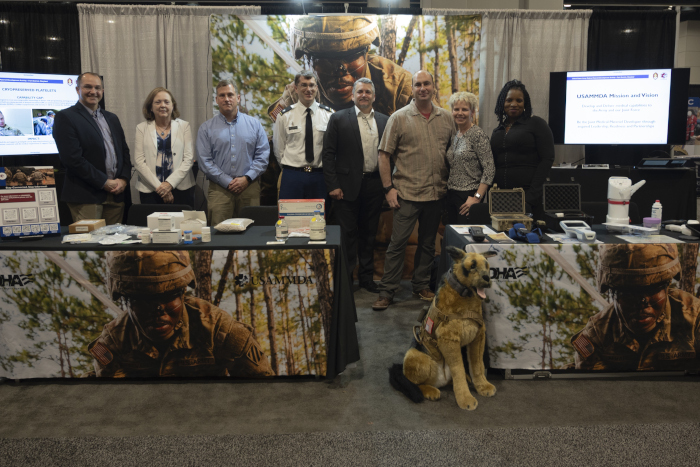
Team members with the U.S. Army Medical Materiel Development Activity gather for a photo during the Special Operations Medical Association (SOMA)
annual conference, Raleigh, North Carolina, May 14, 2024. USAMMDA, a subordinate activity of the U.S. Army Medical Research and Development Command
at Fort Detrick, Maryland, is comprised of four Project Management Offices. Coordinating with DoD, non-DoD and government stakeholders, team members
from the individual PMOs work to develop and deliver lifesaving and life-preserving devices, treatments, drugs, vaccines, and medical support
equipment for the military Joint Forces.
(U.S. Army Photo by Cameron E. Parks/Released)
Team members with the U.S. Army Medical Materiel Development Activity participated in the Special Operations Medical Association (SOMA) annual conference, Raleigh, North Carolina, May 13-16, 2024.
SOMA brings together experts in prehospital, tactical, wilderness, austere, disaster, and deployed medicine to advance the art and science of special operations medical care, according to the organization's website. The conference is an opportunity for medical providers and experts from across the Department of Defense, medical development industry, and academia to discuss the current and future states of military medicine, and to showcase capabilities and information about development programs designed to preserve and protect America's Warfighters.
"SOMA was a great opportunity for USAMMDA to connect with stakeholders from across the spectrum of the development industry and to show our partners in the DoD what we are doing to equip the Joint Forces," said U.S. Army Sgt. 1st Class Andrew Procter, senior enlisted advisor with USAMMDA. "It is important for our team to act as ambassadors for the Army's medical development mission and make connections with potential partners inside the DoD, academia, and private sector."
Procter believes events like SOMA extend USAMMDA's reach and help build momentum for future development opportunities.
"Because our mission to support frontline medics, corpsmen and medical officers never ends, it is important for us to connect with the wider community and seek relationships with the organizations we rely on for our success, and events like SOMA are a key to that bridgebuilding," said Procter.
click the images below to enlarge
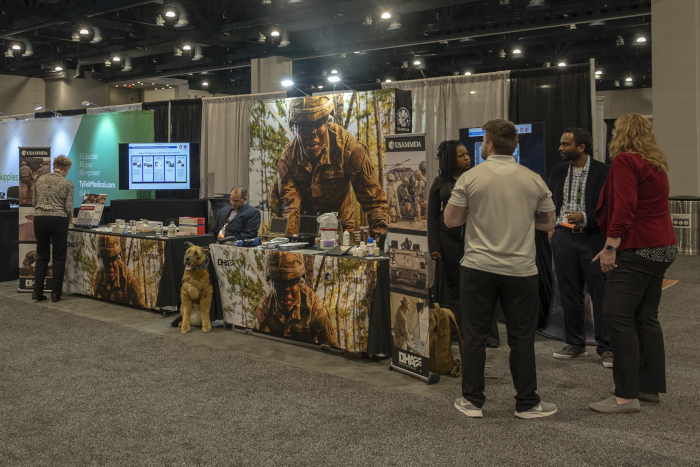
Team members with the U.S. Army Medical Materiel Development Activity wait for the opening of the Special Operations Medical Association (SOMA)
annual conference, Raleigh, North Carolina, May 14, 2024. USAMMDA, a subordinate activity of the U.S. Army Medical Research and Development Command
at Fort Detrick, Maryland, is comprised of four Project Management Offices. Coordinating with DoD, non-DoD and government stakeholders, team members
from the individual PMOs work to develop and deliver lifesaving and life-preserving devices, treatments, drugs, vaccines, and medical support
equipment for the military Joint Forces.
(U.S. Army Photo by Cameron E. Parks/Released)
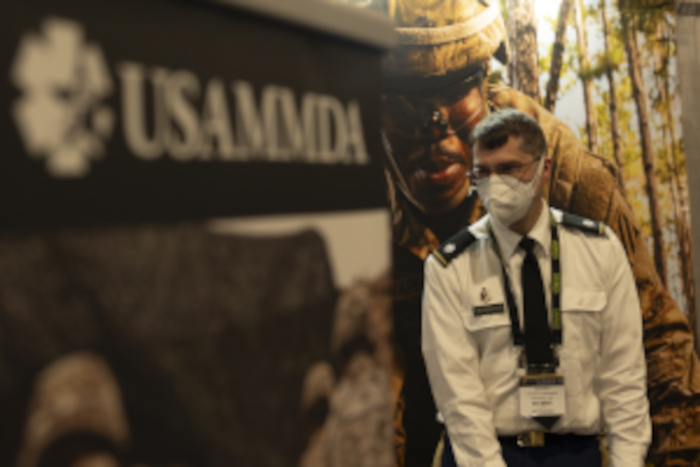
U.S. Army Lt. Col. Stephen Crimmins, an assistant product manager with the U.S. Army Medical Materiel Development Activity, waits for the opening of
the Special Operations Medical Association (SOMA) annual conference, Raleigh, North Carolina, May 14, 2024. USAMMDA, a subordinate activity of the
U.S. Army Medical Research and Development Command at Fort Detrick, Maryland, is comprised of four Project Management Offices. Coordinating with DoD,
non-DoD and government stakeholders, team members from the individual PMOs work to develop and deliver lifesaving and life-preserving devices,
treatments, drugs, vaccines, and medical support equipment for the military Joint Forces.
(U.S. Army Photo by Cameron E. Parks/Released)
According to planners, SOMA is the largest gathering of special forces medical providers in the world, and includes U.S. military, foreign military, domestic tactical law enforcement, and tactical EMS providers.
During the conference, USAMMDA experts showcased the current top-tier medical development programs managed by the organization. Another notable feature of USAMMDA's contribution to the conference was a clinical vignette presented by former special forces medic and USAMMDA guest Andrew Patrick.
Patrick, a former U.S. Navy corpsman with the 1st Marine Raider Battalion and current student at Stanford University, detailed his role as a special operations medic and how French Freeze-Dried Plasma, a treatment fielded and managed by USAMMDA's Force Health Protection Directorate, was used during real-world operations in the Philippines in 2020.
click the images below to enlarge
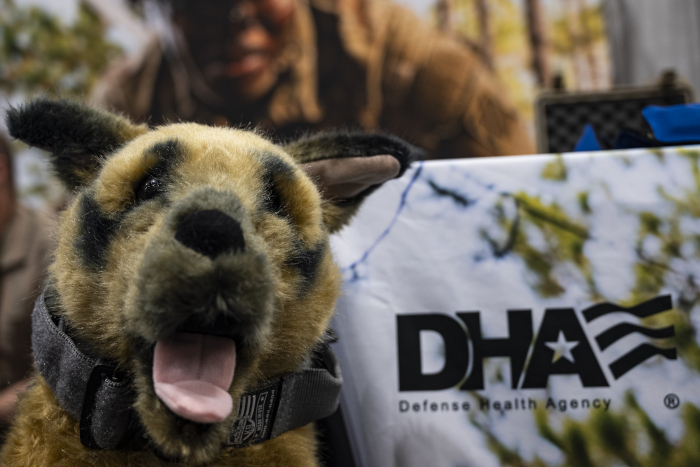
A model Military Working Dog sits on display at the U.S. Army Medical Materiel Development Activity booth as part of the Special Operations Medical
Association (SOMA) annual conference, Raleigh, North Carolina, May 14, 2024. The USAMMDA team members are attending SOMA to showcase the current
top-tier medical development programs managed by the organization. USAMMDA, a subordinate activity of the U.S. Army Medical Research and Development
Command at Fort Detrick, Maryland, is comprised of four Project Management Offices. Coordinating with DoD, non-DoD and government stakeholders, team
members from the individual PMOs work to develop and deliver lifesaving and life-preserving devices, treatments, drugs, vaccines, and medical support
equipment for the military Joint Forces.
(U.S. Army Photo by T. T. Parish/Released)
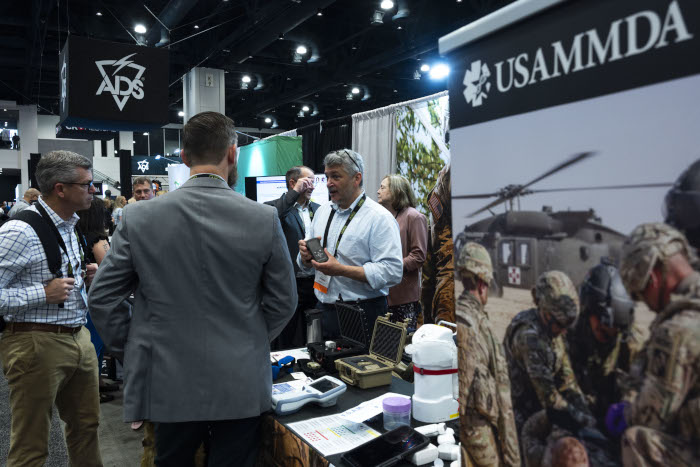
Lou Jasper speaks with attendees at the Special Operations Medical Association (SOMA) annual conference, Raleigh, North Carolina, May 15, 2024. Jasper
is the project manager for the Warfighter Readiness, Performance and Brain Health Project Management Office with the U.S. Army Medical Materiel Development
Activity. USAMMDA is a subordinate activity of the U.S. Army Medical Research and Development Command at Fort Detrick, Maryland. Coordinating with DoD,
non-DoD and government stakeholders, USAMMDA team members work to develop and deliver lifesaving and life-preserving devices, treatments, drugs, vaccines,
and medical support equipment for the military Joint Forces.
(U.S. Army Photo by Cameron E. Parks/Released)
"Freeze-Dried Plasma has a variety of benefits. Looking at the history of medicine, dating back to World War II, we were using tourniquets, whole blood, and Freeze-Dried Plasma. Then after WWII, we started going toward stuff that can be mass produced like crystalloids and colloids, which [could be] worse for the patient," said Patrick during his presentation. "But ever since we started deploying to Iraq and Afghanistan, where we [were] dealing with these multi-system trauma patients, we're moving a lot closer to tourniquets, Freeze-Dried Plasma, and fresh whole blood. And I think Freeze-Dried Plasma is one of the things that are [underused] right now and could have a big impact in the future."
Along with both human and canine FDP (developed for use with military working dogs), USAMMDA currently has more than two dozen ongoing research and development efforts across the spectrum of combat casualty care. USAMMDA team members spoke with dozens of development experts during SOMA to highlight these efforts and spread awareness of current development programs, network with industry representatives, and cultivate future opportunities.
click the images below to enlarge
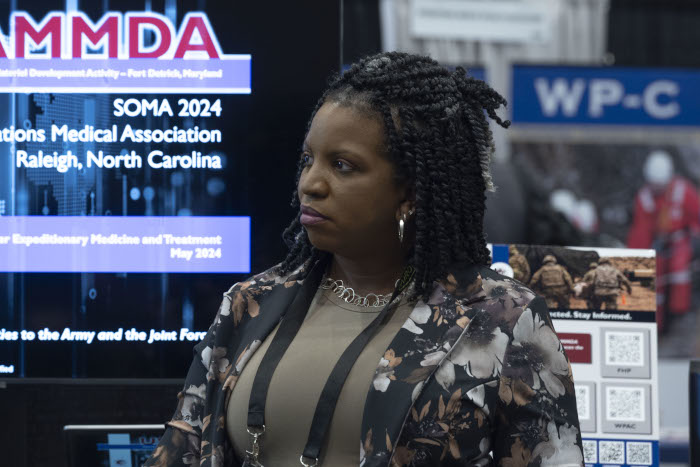
Jericsa Rogers staffs the U.S. Army Medical Materiel Development Activity booth as part of the Special Operations Medical Association (SOMA) annual
conference, Raleigh, North Carolina, May 15, 2024. Rogers is a logistics management specialist with USAMMDA's Warfighter Expeditionary Medicine and
Treatment Project Management Office. USAMMDA is a subordinate activity of the U.S. Army Medical Research and Development Command at Fort Detrick,
Maryland. Coordinating with DoD, non-DoD and government stakeholders, USAMMDA team members work to develop and deliver lifesaving and life-preserving
devices, treatments, drugs, vaccines, and medical support equipment for the military Joint Forces.
(U.S. Army Photo by Cameron E. Parks/Released)
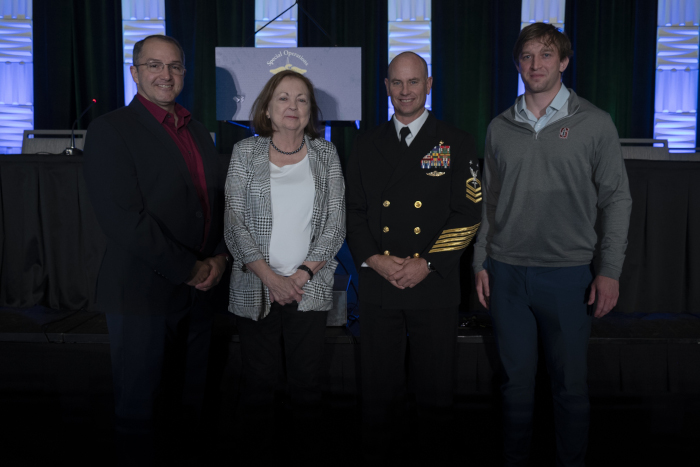
Chris Weselek, Tami Pratt, Master Chief Petty Officer Justin Wilson, and Andrew Patrick gather for a photo during the Special Operations Medical
Association (SOMA) annual conference, Raleigh, North Carolina, May 16, 2024. Weselek is a project management specialist and Pratt is deputy director,
both with the U.S. Army Medical Materiel Development Activity's Force Health Protection Division. Wilson is the senior enlisted advisor with Joint
Trauma System, Defense Health Agency, and Patrick, currently a student at Stanford University, is a former U.S. Navy corpsman who served with the 1st
Marine Raider Battalion. During deployment to the Philippines in 2020, Patrick treated a rescued hostage with French Freeze-Dried Plasma, stabilizing
the patient for transport to a higher care facility. Patrick attended SOMA 2024 as a guest of the U.S. Army Medical Materiel Development Activity,
which manages the FFDP product. USAMMDA is a subordinate activity of the U.S. Army Medical Research and Development Command at Fort Detrick, Maryland.
Coordinating with DoD, non-DoD and government stakeholders, USAMMDA team members work to develop and deliver lifesaving and life-preserving devices,
treatments, drugs, vaccines, and medical support equipment for the military Joint Forces.
(U.S. Army Photo by Cameron E. Parks/Released)
USAMMDA, a subordinate activity of the U.S. Army Medical Research and Development Command at Fort Detrick, Maryland, is comprised of four Project Management Offices. Coordinating with DoD, non-DoD and government stakeholders, team members from the individual PMOs work to develop and deliver lifesaving and life-preserving devices, treatments, drugs, vaccines, and medical support equipment for the military Joint Forces.
For more information about USAMMDA and how to partner with the U.S. Army medical development enterprise, visit https://usammda.health.mil/.
Last Modified Date: 01/14/2025




















